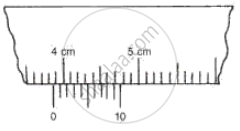Advertisements
Advertisements
प्रश्न
उत्तर
In this case, the zero error is positive
Least count of screw gauge = 0.01 mm
Thus, zero error = 0 + 4 X L.C. = 0.04 mm
APPEARS IN
संबंधित प्रश्न
Define the term 'Vernier constant'.
A vernier callipers has a zero error of + 0.06 cm. Draw a neat labelled diagram to represent it.
A screw gauge has 50 divisions on its circular scale and its screw moves by 1 mm on turning it by two revolutions. When the flat end of the screw is in contact with the stud, the zero of the circular scale lies below the base line and 4th division of the circular scale is in line with the base line. Find
(i) The pitch,
(ii) The least count and
(iii) The zero error of the screw gauge
Who invented vernier callipers?
A micrometre screw gauge having a positive zero error of 5 divisions is used to measure diameter of a wire, when reading on the main scale is 3rd division and the 48th circular scale division coincides with baseline. If the micrometer has 10 divisions to a centimetre on the main scale and 100 divisions on a circular scale, calculate
- Pitch of screw
- Least count of screw
- Observed diameter
- Corrected diameter.
Name the measuring employed to measure the thickness of a paper.
State whether the following statement is true or false by writing T/F against it.
A metre scale can measure a length of 6.346 cm.
The following figure shows the reading of a vernier caliper used for measuring the thickness of a metal sheet.
(i) Find the least count of the instrument.
(ii) Calculate the thickness of the metal sheet.

A vernier caliper using the scale invented by Galileo.
